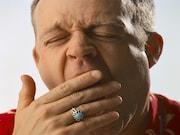Nonpharmacological, practical interventions tied to improvements in mental well-being, performance
TUESDAY, June 11, 2019 (HealthDay News) — Simple tweaks to eating and sleeping patterns of “night owls” can lead to significant improvements in sleep/wake timing, according to a study recently published in Sleep Medicine.
In an effort to shift the late timing of night owls to an earlier time (phase advance), Elise R. Facer-Childs, Ph.D., from the University of Birmingham in the United Kingdom, and colleagues randomly assigned 22 individuals to a normal schedule or the intervention. For three weeks, the intervention included the following: (1) waking up two to three hours before regular wake-up time and maximizing outdoor light during the mornings; (2) going to bed two to three hours before habitual bedtime and limiting light exposure in the evening; (3) keeping sleep/wake times fixed on both work days and free days; and (4) having breakfast as soon as possible after waking up, eating lunch at the same time each day, and refraining from eating dinner after 7 p.m.
The researchers found that overall, participants demonstrated a significant advance of approximately two hours in sleep/wake timings as determined by actigraphy and circadian phase markers (dim light melatonin onset and peak time of the cortisol awakening response). No adverse effect on sleep duration was noted. Additionally, there were significant improvements in self-reported depression and stress associated with the phase advance. Finally, the phase advance was accompanied by improved cognitive (reaction time) and physical (grip strength) performance measures during the typical “suboptimal” morning hours.
“Our findings propose a novel strategy for shifting clock timing towards a pattern that is more aligned to societal demands that could significantly improve elements of performance, mental health, and sleep timing in the real world,” the authors write.
Copyright © 2019 HealthDay. All rights reserved.








